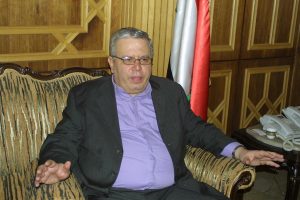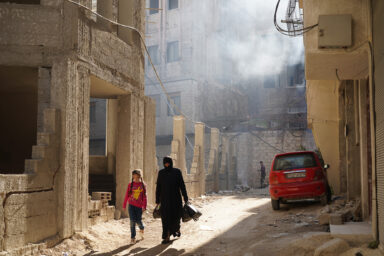Who Really Used Chemical Weapons in Syria? Journalist Reese Erlich digs into that question in this exclusive excerpt from his new book "Inside Syria: the Backstory of Their Civil War and What the World Can Expect".
The videos shocked the world. Hundreds of bodies lay on the floor of makeshift morgues in and around the town of Al Ghouta on the southeastern outskirts of Damascus.
Early in the morning of August 21, 2013, Sarin gas killed hundreds of men, women, and children. Victims suffered horrible deaths, going into spasms and gasping for air. The videos, produced by the rebels, blamed the Syrian army.
The following article is adapted from journalist Reese Erlich’s new book, “Inside Syria: the Backstory of Their Civil War and What the World Can Expect”.
***
The Obama administration strongly condemned the Assad regime and over the next few weeks prepared to bomb Syria in retaliation. The rebels hoped the American bombing raids would destroy Assad’s air force and lead to an opposition victory.
The Assad regime argued that the rebels, not the government, had fired the chemical weapons in order to provoke a US assault on Damascus. UN weapons inspectors eventually issued two reports on the use of chemical weapons. Investigative reporters cast doubts on some of the Obama administration’s claims. The controversy deepened over time.
So the question remains: Who used chemical weapons and why? First, the official US government version.

The US Government Account:
On August 30, the White House issued a “government assessment” about the Al Ghouta attack. It stated that the Sarin gas killed 1,429 people, including 426 children. The White House stated that the Syrian military had used chemical weapons previously. The assessment said, “We assess that the opposition has not used chemical weapons. We assess that the regime’s frustration with its inability to secure large portions of Damascus may have contributed to its decision to use chemical weapons on August 21.”
The US position seemed to gather strength when Human Rights Watch and the New York Times indicated they had independently analyzed information that calculated the trajectory of the rockets that landed in the Al Ghouta area.
Rick Gladstone and C.J. Chivers of the Times wrote that rockets were fired from a military complex solidly under government control, some nine kilometers from the Al Ghouta sites. Chivers wrote that the rockets were fired from Mount Qasioun, which he described as “Damascus’s most prominent military position. . . . It is also a complex inseparably linked to the Assad family’s rule.” The article held the top forces of the regime responsible for the attack and discounted the possibility that a rogue officer or a rebel mole carried it out.
***
Within weeks, the U.S. version of events began to fall apart. First was the matter of civilian deaths. The White House figure of 1,429, a strangely precise number for estimating mass deaths, was nearly three times the size of the highest estimates of other reliable sources. Doctors Without Borders, which had medical personnel on the ground in Al Ghouta, estimated 355 deaths. British intelligence indicated 350, and the pro-opposition Syrian Observatory for Human Rights counted 502. Only the Syrian National Coalition, the opposition group backed by Western powers, agreed with the U.S. estimate. But when pressed by the Associated Press for a list of names, it could come up with only 395.
Ake Sellstrom, head of the UN chemical-weapons inspection team, said the rebels significantly exaggerated the number of dead and injured treated in Al Ghouta hospitals. “We saw the capability of those hospitals, and it is impossible that they could have turned over the amount of people that they claim they did.” The discrepancy was explained when The Wall Street Journal revealed that U.S. intelligence had scanned the rebel videos with face recognition software to count the number of dead. They made no on-scene investigation.
Second, serious questions arose about the White House claim that the Sarin rockets were fired from the heart of Assad-controlled Damascus. The New York Times and Human Rights Watch analyses assumed that the rockets were fired from over nine kilometers away.
***
But a report published by missile experts showed otherwise. Richard Lloyd is a former UN weapons inspector and currently works at Tesla Labs in Arlington, Virginia. Theodore A. Postol is a professor of science, technology, and national security policy at the Massachusetts Institute of Technology in Boston.
They analyzed the data presented by the UN inspectors concerning the Sarin-laden rockets. They concluded that the rockets would have a maximum range of two kilometers. When asked about this issue at a press conference, Sellstrom concurred that the two kilometer range would be a “fair guess.” He later indicated the rockets could have been fired as close as one kilometer.
Lloyd and Postol superimposed the two kilometer rocket range onto the White House maps. Their report said, “These munitions could not possibly have been fired at east Ghouta from the ‘heart,’ or from the eastern edge, of the Syrian government-controlled area shown in the intelligence map published by the White House on Aug. 30, 2013.”
The report noted that these “improvised artillery rockets” could have been constructed by the army or the rebels. “The indigenous chemical munition could be manufactured by anyone who has access to a machine shop with modest capabilities, that is, the claim is incorrect that only the Syrian government could manufacture the munition.” The New York Times wrote about the report and noted the much shorter range but never retracted its erroneous reports that the rockets must have been fired from the Mount Qasioun military complex.
Poking holes in the U.S. government’s case doesn’t automatically mean the rebels were responsible, however. Were the rebels militarily capable and politically willing to carry out a massive war crime against their own supporters?
The Syrian Version
As a liquid, Sarin is quite volatile and can’t be stored for very long because it can corrode storage containers and warheads. So Sarin precursor chemicals are stored separately and then mixed prior to use. They can be mixed in a lab by trained technicians. Mixing in the battlefield can be very dangerous to both the technician and anyone nearby. The Syrian army has admitted having Sarin precursors in large quantities. Some extremist rebel groups may have had some as well.
I spent some time in Damascus interviewing government officials and experts about the chemical-weapons issue. The Syrians presented a version of events sharply at odds with the U.S. government narrative.
On March 19, 2013, rebels used Sarin against a pro-government neighborhood in the village of Khan Al Asal near Aleppo, according to Dr. Bassam Barakat, a medical doctor and pro-government political consultant. He told me that blood samples and other physical evidence were sent to Russia for analysis. Officials there wrote a 100-page report indicating rebel use of Sarin and delivered it to the United Nations, but neither party ever made it public. According to Barakat, the Russians confirmed that the Sarin had originally come from the chemical stockpiles of Libyan dictator Muammar Qaddafi, who had been supplied by the old Soviet Union. Extremists in Libya shipped the Sarin chemical precursors to Turkey, where they were then smuggled across the border into Syria, according to Barakat. Assad officials were so confident that they could prove the rebels had used the poison chemicals, they allowed UN inspectors into Syria to investigate, but only after months of delay.
The final UN chemical-weapons report confirmed a number of points in the Syrian government version. Rebels were shelling Khan Al Asal prior to the chemical attack. At about 7:00 a.m., a munition hit the area some 300 meters from a government checkpoint. The UN report indicated, “The air stood still and witnesses described a yellowish-green mist in the air and a pungent and strong sulfur-like smell. . . . The witnesses reported seeing people scratching their faces and bodies. They also observed people lying in the streets, some unconscious, some having convulsions and foaming from the mouth.”
The UN inspectors concluded that Khan Al Asal had been attacked with Sarin. The UN inspection team was unable to visit the town due to security concerns but was able to interview eyewitnesses and take medical samples of residents who had come to Damascus. A Syrian government report indicated that twenty people died from the Sarin attack and 124 were injured.
Interpreting the Facts
Those are the facts. Now the interpretation. It’s been my experience that if something doesn’t make sense politically, it doesn’t make sense militarily. In this case, why would the Syrian army attack its own village? If it was seeking to discredit the rebels, why kill and injure so many of its own soldiers and civilians? On the other hand, the rebels—particularly extremists of al-Nusra and the Islamic State—would gain a lot from the use of chemical weapons. They would both kill the enemy, which included pro-Assad civilians, and discredit the Assad regime by blaming it for the attack.
One high UN official admitted that the Syrian government was not responsible for Khan Al Asal. Carla del Ponte told a Swiss TV interviewer, referring to the Asal incident, “This was use on the part of the opposition, the rebels, not by the government authorities.” Del Ponte was a member of the UN Independent Commission of Inquiry on Syria and a former war-crimes prosecutor for the International Criminal Tribunal for the former Yugoslavia. After her initial statement, she and other members of the commission of inquiry stopped commenting.
Then, in late May, Turkish newspapers reported that suspected members of al-Nusra were arrested carrying two kilograms of Sarin with plans to attack the US Air Force base at Adana, Turkey. By the time the case came to trial, however, the Turkish government did not prosecute the men for possessing Sarin. There’s no public record on why prosecutors didn’t pursue the chemical-weapons issue.
In another incident in late May, Iraqi authorities arrested five alleged members of the Islamic State for building two labs to manufacture Sarin and mustard gas. At a press conference, the police displayed lab equipment and weapons. At the time the Islamic State was part of al-Nusra and was also carrying out its own activities inside Syria.
Al-Qaeda Rebels Had Chemical Weapons Expertise
So it appears that al-Qaeda-affiliated rebels had the expertise and capability to carry out small-scale chemical attacks. In Khan Al Asal they may well have deployed Sarin against the Syrian army and its supporters.
The Syrians charge there was another, virtually unknown chemical-weapons attack in May 2013. Dr. Bassam Barakat described a Sarin attack on an army checkpoint near the Scientific Studies and Research Center in Damascus, an area near Hamish Hospital. Barakat said a rebel mortar shell packed with Sarin hit dozens of Syrian soldiers. Twenty died and one hundred were injured, according to Barakat.

Syrian Minister of Justice Najm al-Ahmad confirmed the attack. “The soldiers died of suffocation,” he told me. He and Barakat argued that the Syrian army wouldn’t use chemical gas against its own soldiers, and therefore the rebels had to be responsible. The incident was briefly reported on Syrian TV at the time but not mentioned further. I asked both men why such a horrific attack was not more widely publicized by the Syrian government. After all, an attack of such magnitude against government soldiers would point suspicion directly at the rebels. As far as I can tell, the incident was never reported to the United Nations and certainly wasn’t included in the inspector’s reports.
The United Nations reported a total of seven alleged chemical weapons incidents. Inspectors were unable to collect enough data in some cases. Incidents included attacks on both rebel and pro-government areas. So what does this mixed record of likely responsibility mean for the massive attack on Al Ghouta?
***
The Al Ghouta victims lived in rebel-controlled areas in towns to the southeast of Damascus. Virtually all the victims were treated in rebel-controlled medical facilities, not government hospitals. The UN inspectors were able to examine the Al Ghouta area in a timely manner. They collected contaminated soil, took medical samples from victims, and located at least some of the munitions used.
The United Nations concluded that without doubt victims had been exposed to Sarin. The gas was delivered by guided rockets and artillery-fired rockets. The guided rockets, a modified version of an old Soviet Grad, were launched independently. The other munitions, which have tail fins, are fired from artillery but have no independent guidance system.
UN inspectors found five munitions carrying Sarin that hit the Al Ghouta area. Each of the two Grads were capable of carrying thirteen gallons of Sarin, and three artillery-launched rockets could carry eleven to sixteen gallons each. If those figures are correct, and the munitions were filled to capacity, whomever fired the rockets had to either transport the Sarin from a sophisticated lab or mix and load fifty-seven to seventy gallons of liquid Sarin in battlefield conditions, which is no small task.
London-based chemical-weapons expert Dan Kaszeta told me that such a batch of Sarin would require a huge amount of “precursor chemicals and produce a significant waste stream.” An organized army with proper facilities and trained technicians seemed to be the likely culprit. On the other hand, if UN inspector Sellstrom, as well as professors from MIT and Tesla Labs, are correct on the rocket trajectory, the rockets were fired from areas very near to or under rebel control.
Assad Stupid Enough to Attack?
And the political question remains: Why would Assad be stupid enough to launch a major chemical attack just days after UN inspectors entered Damascus? He may be evil, but he’s not stupid. Justice Minister Ahmad told me, “When the Syrian army was making progress in Al Ghouta, the terrorists wanted the world to look at another issue, so they used chemicals again.”
Joshua Landis, director of the Center of Middle Eastern Studies at the University of Oklahoma, offered a possible answer as to why the Syrian army used weapons of mass destruction. He told me that the regime was fighting a desperate battle in the suburbs against rebels who had considerable popular support among Sunni residents. Assad didn’t have the troops to retake all the towns, so the army used Sarin. “It’s like sending the U.S. Marines into Japan in 1945. But the United States used atomic weapons.”
He noted that “Syria doesn’t operate its military efforts around weapons inspectors. As long as the United States wouldn’t invade, he [Assad] could get away with anything.”
Investigative reporter Gareth Porter offered another explanation. He argued that much less Sarin was used than commonly thought. The rebels could have diluted Sarin with water. So they would only have had to manufacture as little as fifteen gallons of Sarin. Some victims showed symptoms inconsistent with Sarin poisoning, possibly caused by tear gas or smoke grenades. Under Porter’s theory, extremist rebels didn’t have to transport dozens of gallons of Sarin from Turkey to Al Ghouta.
“The new information suggests a much less lethal attack with munitions that were less effective and perhaps even using much less Sarin than was initially assumed,” he wrote.
So what conclusions can we draw? Both sides quite possibly used Sarin. Both sides lied and manipulated evidence. At a minimum, the Obama administration exaggerated its case to justify a military attack on Syria. At worst, the White House fabricated intelligence. Bottom line: no one has yet presented convincing evidence of who perpetrated the horrific Al Ghouta attack.
[box] WhoWhatWhy plans to continue doing this kind of groundbreaking original reporting. You can count on us. Can we count on you? What we do is only possible with your support.
Please click here to donate; it’s tax deductible. And it packs a punch.[/box]

